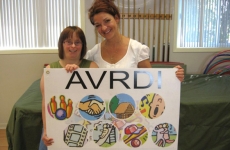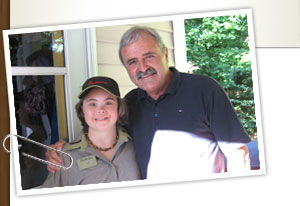Networks of Families
Families networks are different in that they are not primarily focused on the support of one individual. Families networks are committed to helping one another through listening, sharing of ideas, resources, and wise counsel, and sometimes through shared family gatherings that allow their young people to meet and socialize.
One example of a families network is Faith and Light. Its groups have a well-established structure and are most often Catholic but can be ecumenical. Its format could be adapted by other faith communities.
Faith and Light - Mary, Vanessa and Jaclyn
Mary describes Faith and Light, a organization started by Jean Vanier and Marie-Helene Matthieu for families who have a member with an intellectual disabilty and their friends. Faith and Light has many groups across Canada. Jaclyn and Vanessa talk about their experience of being in a Faith and Light group.
Download TranscriptInvestigate your local area. There may already be a support network of families. Check with Community Living Associations and with smaller agencies and with recreational organizations such as Special Olympics.
In Canada a number of the Christian and Jewish organizations that serve people with intellectual disabilities also help families to meet each other and network. Many are interdenominational and open to people of other faiths. The CanadianAssociation of Muslims with Disabilities (CAM-D) is an interdenominational Muslim organization that promotes educational initiatives, and works to create networks of families who have members with a disability. CAM-D is also leading a task force looking at residential options for families of African, Middle Eastern and South Asian origins who prefer a lifestyle within their cultural and faith values.
(A document lower on this page will give you more information about groups working to create links between families including the work of Rabia Khedr, disability activist and founder of CAM-D.)
Read more about the efforts of Rabia Khedr, founder of the Canadian Association of Muslims with Disabilities, and about CAM-D.
If there is nothing, try to get something started!
1) Brainstorm with another family to identify the elements both your families are looking for.
Are there specific needs of their family member that you can be aware of, and vice-versa?
Are there other families you can invite in?
Are there teen-aged sibs who want to invite their friends?
Try to set up something that allows for regular interaction in a casual setting.
2) Agree on a budget to which each family contributes. Keep the amount low. Social gatherings can cost very little—a picnic in a nearby park, time at a toboggan slide followed by a get-together at a home for hot chocolate.
3) Focus: The families in a network may share a common outlook with regard to educational philosophy and disability issues. They may work together on advocacy. Some groups are more intentional and more stable and others more fluid. Some members of these networks may also be members of a support network for a child of one of the other families.
Understandably, finding or creating a network of families is not necessarily the first priority. It usually waits until personal support networks are in place. But it is never too early to start talking and gleaning wisdom from other families of youth with disabilities.
A note about formally organizing and fund-raising:
Sometimes families networks apply for funding for their group. This process can be complex and time-consuming and any funding available is usually seed money. Your group will need to find a way of sustaining itself later. This may be possible if you are starting a service for your family members for instance, but this can be a major undertaking. Running small fund-raisers that also allow fun time together or finding a local sponsor may work best for helping cover the costs of special trips or projects beyond what the individual families can contribute.
Sometimes 3 or 4 families pool their resources informally and host a day program that may move from home to home and include volunteer placements. An example of families establishing a more formal organization is The Able Network, described in the Good Practices in Action section of this site.
Finding reciprocity can be a struggle. However, the rewards for your family member are great: When we come together as families the young people identify each other and see that they are not alone in being different.”
EF, Family Member, QC
Reach out to create links. Participation in a recreation club or community centre allows you to form lasting relationships with other families. Announce your group’s special activities through the local news media to increase public awareness.
Family Member, QC

Reaching Out and Creating Reciprocity
Getting involved in a recreational association allows for creation of lasting links of friendship. Johanne, sister-in-law of Kim, writes, “We announce our activities in the local newspapers so as to let the general public know about our activities. We also create a sense of belonging through a team T-shirt worn by all the young people. In the photo Johanne and Kim are holding the AVRDI sign.
Johanne Savard is the Executive Director of this association, called AVRDI. More information about it is available in Good Practices in Action in the Additional Resources section.


